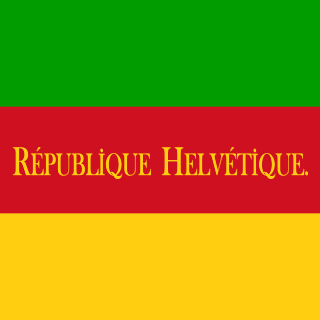
The 26 cantons of Switzerland are the member states of the Swiss Confederation. The nucleus of the Swiss Confederacy in the form of the first three confederate allies used to be referred to as the Waldstätte. Two important periods in the development of the Old Swiss Confederacy are summarized by the terms Acht Orte and Dreizehn Orte.

The canton of St. Gallen or St Gall is a canton of Switzerland. The capital is St. Gallen.

The Helvetic Republic was a sister republic of France that existed between 1798 and 1803, during the French Revolutionary Wars. It was created following the French invasion and the consequent dissolution of the Old Swiss Confederacy, marking the end of the ancien régime in Switzerland. Throughout its existence, the republic incorporated most of the territory of modern Switzerland, excluding the cantons of Geneva and Neuchâtel and the old Prince-Bishopric of Basel.

The Canton of Baden was a canton of the Helvetic Republic. Its capital was the town of Baden.

During the French Revolutionary Wars, the revolutionary armies marched eastward, enveloping Switzerland in their battles against Austria. In 1798, Switzerland was completely overrun by the French and was renamed the Helvetic Republic. The Helvetic Republic encountered severe economic and political problems. In 1798 the country became a battlefield of the Revolutionary Wars, culminating in the Battles of Zürich in 1799.

Oberland was the name of a canton of the Helvetic Republic (1798–1803), corresponding to the area of the Bernese Oberland, with its capital at Thun.

The Act of Mediation was issued by Napoleon Bonaparte, First Consul of the French Republic on 19 February 1803 establishing the Swiss Confederation. The act also abolished the previous Helvetic Republic, which had existed since the invasion of Switzerland by French troops in 1798. After the withdrawal of French troops in July 1802, the Republic collapsed. The Act of Mediation was Napoleon's attempt at a compromise between the Ancien Régime and a republic. This intermediary stage of Swiss history lasted until the Restoration of 1815. The Act also destroyed the statehood of Tarasp and gave it to Graubunden.

Linth was a canton of the Helvetic Republic from 1798 to 1803, consisting of Glarus and its subject County of Werdenberg, the Höfe and March districts of Schwyz and the Züricher subject Lordship of Sax, along with a handful of shared territories.

Waldstätten was a canton of the Helvetic Republic from 1798 to 1803, combining the territories of the founding cantons of the Old Swiss Confederacy, Uri, Schwyz and both cantons of Unterwalden, which were collectively known as Waldstätten since the 14th century, along with Zug, the Republic of Gersau, and Engelberg Abbey.

Léman was the name of a canton of the Helvetic Republic from 1798 to 1803, corresponding to the territory of modern Vaud. A former subject territory of Bern, Vaud had been independent for only four months in 1798 as the Lemanic Republic before it was incorporated into the centralist Helvetic Republic. Léman comprised all of the territory of Vaud detached from Bernese occupation, apart from the Avenches and the Payerne which, after 16 October 1802, were annexed by the canton of Fribourg until the Napoleonic Act of Mediation the following year when they were restored to the newly established and newly sovereign canton of Vaud.

Frédéric-César de La Harpe was a Swiss political leader, writer and journalist, best known for his pivotal role in the independence of the canton of Vaud from Bern and in the formation of the Helvetic Republic, in which he served as a member of its Directory. He was a personal teacher of Alexander I of Russia and educated him in the ideas of the Lumières.

The Rhodanic Republic, officially the Republic of Valais or Vallais, was a sister republic of France that existed between 1802 and 1810 in the French-speaking part of Switzerland, during the Napoleonic Wars, in the territory corresponding with the modern Swiss canton of Valais.

Peter Ochs was a Swiss politician who is best known for drawing up the first constitution of the short-lived Helvetic Republic.

Bourla-Papey was the name given to a popular revolt that took place between February and May 1802 in the Canton of Léman, in Switzerland, during the days of the Helvetic Republic. The uprising was in response to the restoration of feudal rights and taxes that had been abolished following the French invasion of 1798. The Bourla-papey seized archives from castles in the area now known as the Canton de Vaud, which they burned in an attempt to destroy records of what was owned by whom, making it impossible to collect taxes.
Subdivisions of the canton of Ticino, Switzerland, are the 108 comuni grouped into 38 circoli, which in turn form a part or the whole of one of the eight districts.

The French invasion of Switzerland occurred from January to May 1798 as part of the French Revolutionary Wars. The independent Old Swiss Confederacy collapsed from the invasion and simultaneous internal revolts called the "Helvetic Revolution". The Swiss ancien régime institutions were abolished and replaced by the centralised Helvetic Republic, one of the sister republics of the French First Republic.
The Helvetische Gesellschaft / Société Helvétique, or Helvetic Society as it is known in English, was a patriotic society and the first Swiss reform society. It was founded by Swiss philosopher Isaak Iselin, poet Solomon Gessner and some 20 others on 15 May 1762, and was dissolved with the formation of the Helvetic Republic in 1798. It was revived again from 1819 on until 1849. The latter should not be confused with the contemporary Helvetic Society for the Natural Sciences, established in 1815.
A constitutional referendum was held in the Helvetic Republic on 25 May 1802. Unlike the constitution approved in 1798, the new constitution, known as the Malmaison constitution, did not provide for any referendums. Non-voters were assumed to have voted in favour of the new constitution, a measure put in place to prevent its rejection. As a result, 72.17% of voters were deemed to be in favour.

The Thurgau was a pagus of the Duchy of Alamannia in the early medieval period. A County of Thurgau existed from the 13th century until 1798. Parts of Thurgau were acquired by the Old Swiss Confederacy during the early 15th century, and the entire county passed to the Confederacy as a condominium in 1460.

Georges Boisot was born in Mézières, Vaud. He was the Minister of Interior of the Helvetic Republic from 1798 to 1803. Later he became Secretary of the Vaud Department of the Interior, followed by a position as State Chancellor of the Swiss canton.













